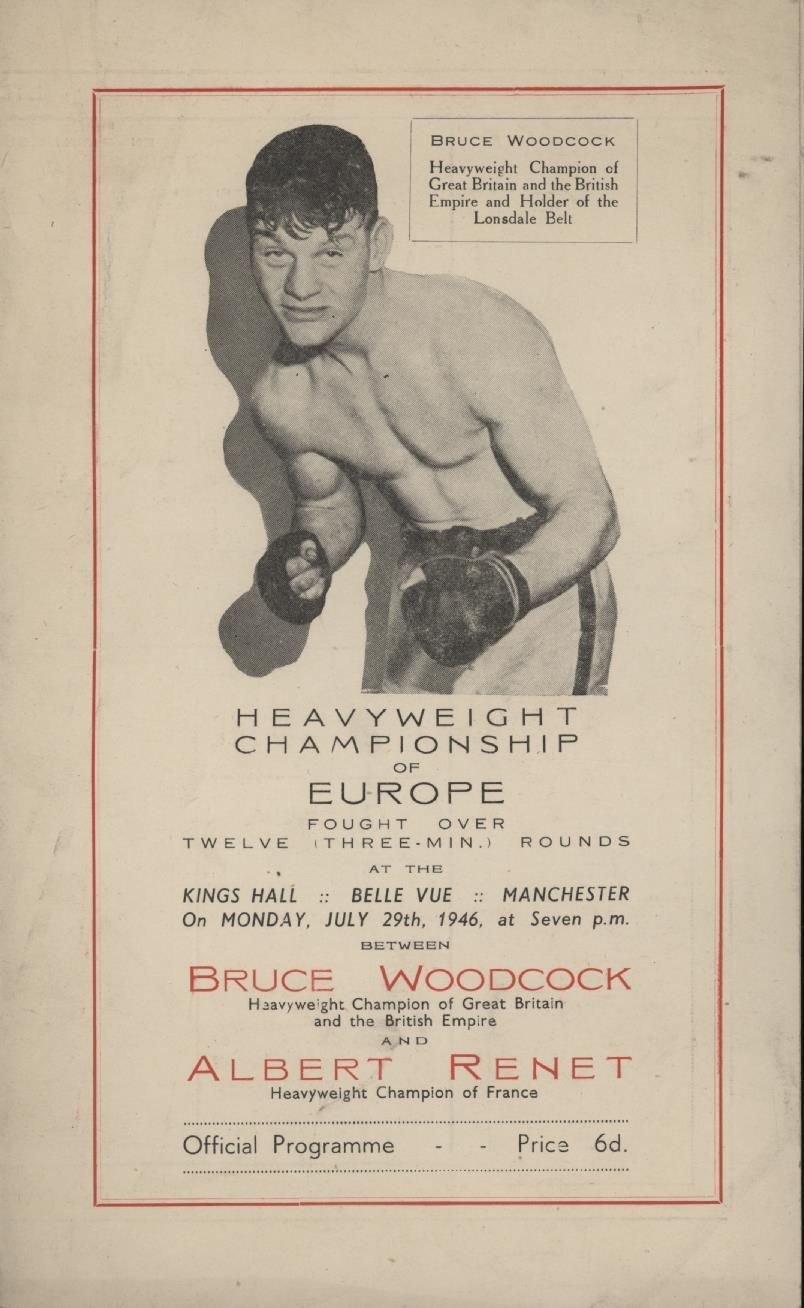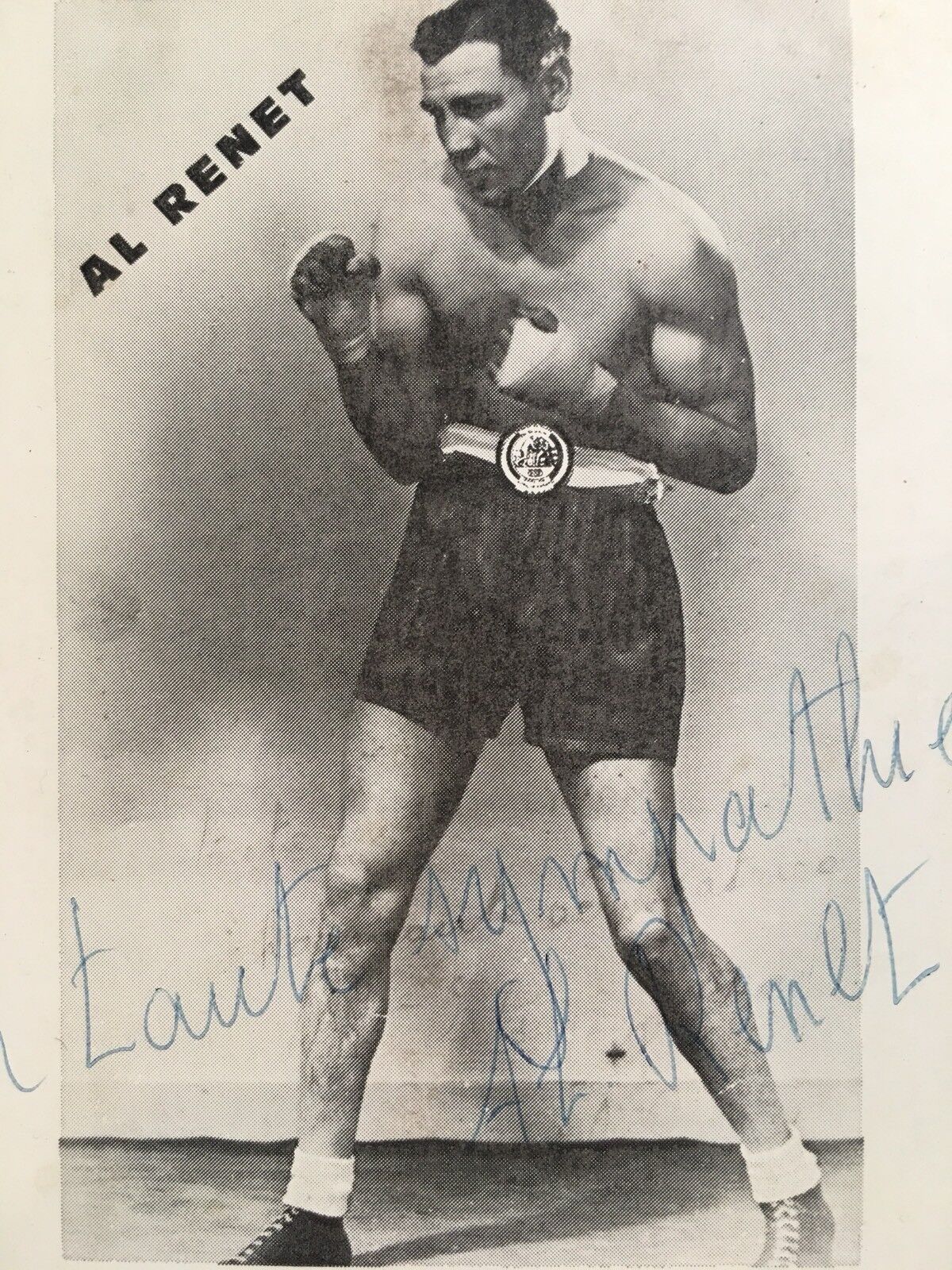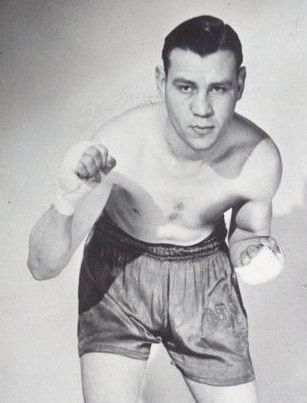29th July - Woodcock vs Albert Renet (Manchester)
Barely six weeks later, Bruce was back in action for an equally prestigious battle. This time the goal was to attain the European heavyweight title. The title was now overseen by the newly formed European Boxing Union. It was currently unoccupied after the previous title-holder Belgian Karel Sys was arrested in 1945 on charges of collaboration and felony, that saw him stripped of his titles. This deciding fight was to be against the French heavyweight champion Albert Renet. Renet, a southpaw aged 28, was a light heavyweight as Bruce had been but he now outweighed the Frenchman, clocking in at 13 st. 13½ lb. to Renet’s 12 st. 5¼ lbs. Adding to the pre-fight anticipation, Bruce was now rated by boxing analysts as the fourth best heavyweight in the world.
The fight was scheduled as fifteen rounds, but Bruce made relatively easy work of it, knocking Renet out in the sixth. That said, he didn't have it all his own way. Renet started the fight seeming totally intimidated and even frightened, but he soon showed he was neither of those things. Bruce found Renet’s southpaw stance puzzling and was very careful with his opponent for the first two rounds. Bruce weighed him up, took his time, allowing Renet to lead and awaited his opportunity. It took until round four: Renet led and received two lefts and a right to the jaw in quick succession, sending him over like a pin in a bowling alley.
Bruce’s speed further increased in the fifth round with three rights sending Renet down for a count of eight. Each time, Renet showed admirable grit and determination, getting up before the count ended, ready once again to trade punches. But there was less and less trading, with Bruce’s right hand commanding his attention and sending him down again and again.
Renet went down for five counts in all, of nine in the fourth, eight in the fifth, nine and eight in the sixth, before the final knockout. This was the first time in 150 fights that Renet had been down on the canvas. However, until the end, he refused to lie down despite receiving some savage punishment. Finally in the sixth, the last punch sent him flat out face down. He had to be carried to his corner. When he came round, he ran over to Bruce’s corner, hugged Bruce and kissed him on both cheeks, French style! Renet received a well-deserved ovation in defeat from the crowd of 6,500, having displayed great courage.
Swedish Exhibition Tour
Before his next world title pathway fight against Gus Lesnevich, Bruce took time out for a working holiday. Accompanied by Nora as well as by Tom Hurst with his wife, he undertook a two week exhibition tour. They visited Riga in Latvia and then Sweden for five matches in Stockholm. The party arrived on 6th August to the excitement of local journalists who reported that Bruce looked sharp, lively and ‘so hearty’ [‘såg så här hjärtegod ut’].
Bruce was due to meet Nisse Andersson at the first of five shows at the Nöjesfältet that evening, and during preparations at the Continental Hotel, photographers made sure their readers saw that Bruce ‘has a great physique’. Andersson, ten kilos heavier, was effectively Bruce’s sparring partner in the four round exhibition show, despite winning the Swedish heavyweight title just a month later in September. Journalists lamented that the fight was merely an exhibition: no Swedish promoter would be willing to risk the minimum 100,000 Swedish krona necessary to put on a proper fight. But when they did eventually meet at Harringay in December, Bruce easily beat Andersson in three rounds.
After the show, Bruce met the older Swedish champion Harry Persson. Known as ‘The Slugging Stonemason’. Persson had won the Scandinavian heavyweight title in 1923 and the EBU European heavyweight title in 1926, leading him to go to America for change to fight Jack Dempsey for the world title. While he had some success, his visit was also blighted by controversial decisions against him and by corruption when he refused to give up his Swedish manager for an American. Back in Sweden he successfully defended his title for eleven more fights before retiring. Bruce couldn’t know it but there were to be some echoes in Persson’s ‘so close’ story.
Meanwhile Nora caught the eye of journalists too who described her as ‘the little sly Betty Boop girl’ by the side of her ‘big, strong fiancé’. They were clearly enamoured by the fact that Bruce’s boxing shorts were embroidered ‘Good Luck’ and that it was this ‘little dark and curly-haired Doncaster seamstress who has carried the embroidery needle and there must have been a loving thought in every stitch she made with the yellow thread.’ Nora herself would no doubt have bridled against such typecasting, being as strong and powerful an individual in her own way as her future husband, Gloria Landis swimsuit or no! The more liberal Swedish journalists, perhaps assuming Britain was still in the staid Victorian age, were also astonished that Bruce and Nora were accompanied by what seemed to be a chaperone. This duty fell to Tom Hurst’s wife, and the couple wouldn’t be photographed alone together because it wouldn’t be acceptable back home! It seemed to them that British women hadn’t advanced as much towards freedom as Swedish and Americans. It’s more likely this was the ever-canny Nora, already aware of the tricks of the journalist trade, making sure someone was watching their backs in such situations. The journalistic admiration of Bruce’s sartorial look was even then quite probably due as much to Nora as Bruce himself:
"A Variety tie from Brooklyn in New York, a simple suit from Main Street, Manchester, a large checkered shirt from Oxford Street in London and a pair of light brown shoes from Klarabergsgatan in Stockholm, Bruce Woodcock is a cosmopolitan type I notice when I make a round with him and his girl to hunt for nylon stockings, a white shirt, self-winding wristwatch and a Swedish suit. But he is a man of efficiency, you can see that in everything he undertakes. Just such a detail as how he kindly but time-savingly serves all the autograph hunters. A grip in the jacket pocket, a stack of pre-printed cards with his picture, signature and a Best Wishes using the autograph's capital letters, B and W."
The Swedish verdict on the exhibition bouts was unanimous: this was the best display of boxing ever seen in Sweden, featuring Bruce’s agility, vivacity and devastating punching. His mobile upper body moved as if on a turntable so that he could put all his weight into the punch while keeping his feet totally balanced. His style was ‘a repertoire of effective subtleties’.
Programmes

Albert Renet Background

We cannot find very much information about Albert Renet. He seems to have had a thirteen year career, but some sources say he fought a lot more bouts than is officially recorded. He fought between both heavywieght and light-heavyweight divisions. He died in 2000.

